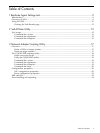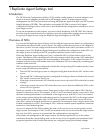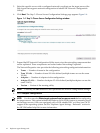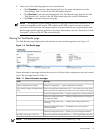
1 Replicate Agent Settings tool
Introduction
The HP Network Configuration Utility (NCU) enables configuration of network adapters and
teams of network adapters installed on an HP Integrity server. To better support server
management, the NCU has been enhanced using the Replicate Agent Settings tool of HP Systems
Insight Manager (HP SIM). The replication tool enables HP SIM to retrieve Web Agent
configuration settings from a source server and distribute that configuration remotely to one or
more target servers.
To use the information in this chapter, you need a basic familiarity with HP SIM. This chapter
provides step-by-step instructions to replicate network configuration settings from one server
to a group of target servers using the Replicate Agent Settings tool of HP SIM.
Overview of NICs
You can use the Replicate Agent Settings tool to configure target servers based on configuration
information transferred from a source server. The target system does not have to be identical to
the source system. You can configure both network interface cards (NICs) and teams of NICs on
the target system. The Replicate Agent Settings tool modifies the configuration of the NICs on
the target system according to the NIC properties specified on the source system.
When the Replicate Agent Settings tool runs, it identifies NICs by their relative order in the
system. The relative order is determined by the slot and port order in the system. NICs embedded
on the system board are assigned the lowest numbers, followed by NICs ordered by their slot
numbers with the lowest slot number listed first. Multiport NICs are ordered by ascending port
number within each slot.
NICs on the target system are configured to match the corresponding NIC numbers on the source
server using the following conventions:
• The first NIC on the target system is configured using data from the first NIC on the source
server.
• The second NIC on the target system is configured according to the saved data for the second
NIC on the source server, and so on.
• If the target system has more NICs than the source server, the extra NICs retain their current
settings.
• If the target system has fewer NICs than the source server, data for additional NICs on the
source server is ignored.
Teams are created on the target system. Each team consists of the same relative NICs that are
teamed on the source server. For example, if NICs 3 and 5 are teamed on the source server, then
the same teaming information is transferred to the target server, and NICs 3 and 5 are teamed
on the target system during the replication operation. In general, the NICs on the target system
team do not have to be the same type of NICs that are teamed on the source server. However,
some NICs cannot be teamed and an error is returned if an attempt to form a team is made with
invalid combinations of NICs. For example, NICs without common speed capabilities cannot be
teamed on a load-balancing team.
An error is returned if the NICs forming the team on the source server are not present on the
target system. For example, if NICs 3 and 5 are teamed on the source server but the target system
has only four NICs, an error is reported and the configuration is not applied.
When teams are configured on the target system, the team properties are set to the values
transferred from the corresponding team on the source server. Properties not transferred (and
properties specified with invalid data values) are configured using their default settings.
Introduction 9


















